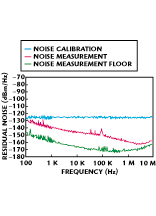Gaussian Noise Calibration Standards
Techtrol Cyclonetics Inc., Advanced Noise Technologies Division
New Cumberland, PA
Measurement of AM and PM noise relating to a carrier signal can be difficult to achieve accurately and consistently. Even when the utmost care is taken in preparing to make a noise measurement and all of the instruments have been calibrated, uncertainties still exist as to whether or not the results form the measurement.
Currently, two reliable noise measurement calibration methods are being used. The simplest but least accurate method involves the use of a carrier signature noise standard. This technique uses the accurately measured noise of a very low noise carrier signal as a noise standard. Because of the circuit complexity of a carrier source, especially at microwave frequencies, reliability relating to the carrier noise can be unpredictable over long time periods.
The second method of achieving AM and PM noise measurement accuracy and traceability involves the use of Gaussian noise. Gaussian noise (specifically, noise that has a very flat energy distribution over a wide frequency range and whereby the AM and PM components are orthogonal and identical in quantity) can be used as a noise standard. However, Gaussian noise is not truly quantifiable energy relative to the accuracies required to produce a traceable standard. Therefore, the use of Gaussian noise as a noise standard requires special techniques to achieve usefulness relative to AM and PM quantity.
 Generally, noise measurements are made with a carrier signal applied to some measuring device. Hence, the use of Gaussian noise as a standard requires that it be associated with carrier energy. This situation allows for both the noise measurement and traceable calibration to be facilitated at virtually the same time. Figure 1 shows a noise measurement calibration using a Gaussian noise standard.
Generally, noise measurements are made with a carrier signal applied to some measuring device. Hence, the use of Gaussian noise as a standard requires that it be associated with carrier energy. This situation allows for both the noise measurement and traceable calibration to be facilitated at virtually the same time. Figure 1 shows a noise measurement calibration using a Gaussian noise standard.
The NAL3000 series wideband Gaussian noise standards utilize accurately characterized Gaussian noise that is quantified to provide a noise standard over a very wide continuous frequency range. Specific portions of the Gaussian noise bandwidth then are selected using filters that are matched to a specific unit. Each filter provides approximately a ±10 percent bandwidth capability at any selected frequency.
These AM and PM noise standards are available from 0.5 to 26 GHz using  three available units. The models NAL3010A, NAL3020A and NAL3030A correspond to frequency ranges of 0.5 to 2 GHz, 1 to 18 GHz and 18 to 26 GHz, respectively. Plug-in filters are used to achieve greater frequency coverage for significantly less cost than previous models. The calibration of the NAL3000 series instruments (with filters) is traceable to the National Institute of Standards and Technology. Each filter is tied back to the individual unit’s serial number. Figure 2 shows the NAL3000 series noise standards’ block diagram.
three available units. The models NAL3010A, NAL3020A and NAL3030A correspond to frequency ranges of 0.5 to 2 GHz, 1 to 18 GHz and 18 to 26 GHz, respectively. Plug-in filters are used to achieve greater frequency coverage for significantly less cost than previous models. The calibration of the NAL3000 series instruments (with filters) is traceable to the National Institute of Standards and Technology. Each filter is tied back to the individual unit’s serial number. Figure 2 shows the NAL3000 series noise standards’ block diagram.
A calibration accuracy of ±1.5 dB can be achieved currently, although efforts are underway to assemble a top-level noise metrology system that will provide considerably more accurate quantitization of Gaussian noise over very wide continuous frequency bandwidths to accuracies of approximately ±0.5 dB. The recommended calibration interval for NAL3000 series products is 12 to 18 months. The calibration noise level is –110 dBm ±5 dB, noise bandwidth is typically ±10 percent of the carrier frequency and noise flatness is ±0.75 dB. The maximum carrier input level is +30 dBm. Phase adjustment is external for the model NAL3010A and 60°/GHz for the models NAL3020A and NAL3030A. Insertion loss is 4 dB for the reference channel and 7 dB for the noise channel; isolation from the reference channel to the noise channel is 30 dB minimum. The half-rack instruments are provided with SMA female RF connectors and are powered by a 120/240 V AC, 57 to 63 Hz supply.
 The NAL3000 series Gaussian noise standards are portable and can be used to achieve traceability for noise measurement systems at varying locations. When applied purely to noise measurement, the standards can be integrated into a noise measurement system to greatly improve both the data reliability and confidence in the noise measurement. Figure 3 shows a typical amplifier residual noise measurement using a NAL3000 series standard for noise calibration.
The NAL3000 series Gaussian noise standards are portable and can be used to achieve traceability for noise measurement systems at varying locations. When applied purely to noise measurement, the standards can be integrated into a noise measurement system to greatly improve both the data reliability and confidence in the noise measurement. Figure 3 shows a typical amplifier residual noise measurement using a NAL3000 series standard for noise calibration.
The NAL3000 series standards can be configured to meet user requirements. The instrument plus one filter is priced at approximately $22,000. Thirteen filters are required to cover the 1 to 18 GHz frequency band at $525 each, and filters may be purchased separately at any time for standard or custom frequency coverage. Specific price and delivery information is available from the manufacturer.
Techtrol Cyclonetics Inc., Advanced Noise Technologies Division,
New Cumberland, PA
(717) 774-2746.
